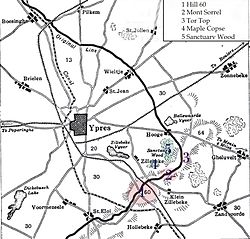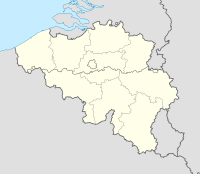
Back Kampf um Höhe 60 (Westfront) German Kukkula 60 (länsirintama) Finnish Bataille de la colline 60 French Hill 60 Dutch Battle of Hill 60 (Western Front) SIMPLE Bitka za hrib 60 (zahodna fronta) Slovenian Hill 60 VLS
| Capture of Hill 60 | |||||||
|---|---|---|---|---|---|---|---|
| Part of the Western Front of the First World War | |||||||
 Hill 60 | |||||||
| |||||||
| Belligerents | |||||||
| |||||||
| Commanders and leaders | |||||||
|
|
| ||||||
| Strength | |||||||
| 1 division | 1 regiment | ||||||
| Casualties and losses | |||||||
| c. 3,100 | |||||||
The Capture of Hill 60 (17 April – 7 May 1915) took place near Hill 60 south of Ypres on the Western Front, during the First World War. Hill 60 had been captured by the German 30th Division on 11 November 1914, during the First Battle of Ypres (19 October – 22 November 1914). Initial French preparations to raid the hill were continued by the British 28th Division, which took over the line in February 1915 and then by the 5th Division. The plan was expanded into an ambitious attempt to capture the hill, despite advice that Hill 60 could not be held unless the nearby Caterpillar ridge was also occupied. It was found that Hill 60 was the only place in the area not waterlogged and a French 3 ft × 2 ft (0.91 m × 0.61 m) mine gallery was extended.
Experienced miners from Northumberland and Wales were recruited for the digging and the British attack began on 17 April 1915. The hill was captured quickly with only seven casualties but then it was found that the salient which had been created, made occupation of the hill costly. Both sides mistakenly accused the other of using poison gas in the April fighting; German attacks on the hill in early May included the use of gas shells and the Germans recovered the ground at the second attempt on 5 May. It remained in German hands until the Battle of Messines in 1917, when two of the Mines in the Battle of Messines were detonated beneath Hill 60 and the Caterpillar.
